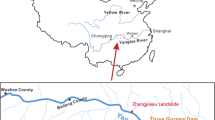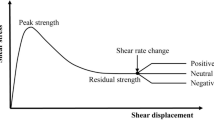Abstract
Shearing rate effect on the residual strength of slip zone soils is considerable for sliding or reactivated landslides. It is complicated and variably affected by external inducing factors, and its variation has not attracted much attention. Using drained ring shear tests on the slip zone soils from two selected landslides with the shearing rates of 0.1–20 mm/min, this study investigated the variation in the shearing rate effect on the residual strength under the influences of the clay fraction, water content, and normal stress. In addition, the shear zone structures were analysed using microscopic observations. The results show that the residual strength decreases with increasing shearing rate (i.e., negative rate effect) and exists a good linear relationship with the logarithmic shearing rates. The slope of the fitting lines of the residual stress ratios versus shearing rates is proposed to assess the shearing rate effects. Furthermore, the effect is significantly affected by the clay fraction, water content, and normal stress. The samples with the low clay fraction exhibit a more significant negative rate effect, and the effect weakens with decreasing water content and normal stress, which are associated with the variations in the shear zone structures due to particle breakage. Additionally, increasing shearing rates and shear displacement change the shear zone structures and thus induce a negative rate effect on the residual strength of the soils.









Similar content being viewed by others
References
Bhat DR, Yatabe R (2015) Effect of shearing rate on residual strength of landslide soils. Eng Geol Soc Territ 2:1211–1215
Ding Z, Hong QH, Wei XJ, Zhang MY, Zheng Y (2017) Experimental study on micro-structure of artificial freezing and thawing soft soil under subway train load. J Zhejiang Univ (Eng Sci) 51(7):1291–1299
Fukuoka H, Sassa K, Wang GH, Sasaki R (2006) Observation of shear zone development in ring-shear apparatus with a transparent shear box. Landslides 3:239–251
Grelle G, Guadagno FM (2010) Shear mechanisms and viscoplastic effects during impulsive shearing. Géotechnique 60(2):91–103
Habibbeygi F, Nikraz H (2018) Effect of shear rate on the residual shear strength of pre-sheared clays. Cogent Geos 4:1453989
Igwe O, Fukuoka H, Sassa K (2012) The effect of relative density and confining stress on shear properties of sands with varying grading. Geotech Geol Eng 30(5):1207–1229
Jeong SW, Park SS, Fukuoka H (2014) Shear behavior of waste rock materials in drained and undrained ring shear tests. Geosci J 18(4):459–468
Jiang Y, Wang GH, Kamai T (2017) Fast shear behavior of granular materials in ring-shear tests and implications for rapid landslides. Acta Geotech 12(3):645–655
Khosravi M, Meehan CL, Cacciola DV, Khosravi A (2013) Effect of fast shearing on the residual shear strengths measured along pre-existing shear surfaces in kaolinite. In: Proceedings of geo-congress 2013, San Diego, America, pp 245–254
Kimura S, Nakamura S, Vithana SB, Sakai K (2014) Shearing rate effect on residual strength of landslide soils in the slow rate range. Landslides 11(6):969–979
Lemos LJL (2003) Shear behaviour of pre-existing shear zones under fast loading-insights on the landslide motion. In: Proceedings of international workshop on occurrence and mechanisms of flow-like landslides in natural slopes and earthfills, Naples, Italy, pp 229–236
Li SD, Li X, Wu J, Liu YH (2007) Evolution process and pattern of sliding zone in large consequent bedding rock landslide. Chin J Rock Mech Eng 26(12):2473–2480
Li X, Liang SY, Zheng GD (2010) Progresses in sliding zone soil of landslides. Adv Earth Sci 25(5):484–491
Li YR, Wen BP, Aydin A, Ju NP (2013) Ring shear tests on slip zone soils of three giant landslides in the Three Gorges Project area. Eng Geol 154:106–115
Li DY, Yin KL, Glade T, Leo C (2017) Effect of over-consolidation and shear rate on the residual strength of soils of silty sand in the Three Gorges Reservoir. Sci Rep 7(1):5503
Liu D, Chen XP (2013) Microscopic observation and analysis of ring shear surface of slip zone soil. Chin J Rock Mech Eng 32(9):1827–1834
Lupini JF, Skinner AE, Vaughan PR (1981) The drained residual strength of cohesive soils. Géotechnique 31(2):181–213
Miao HB, Wang GH, Yin KL, Kamai T, Li YY (2014) Mechanism of the slow-moving landslides in Jurassic red-strata in the Three Gorges Reservoir, China. Eng Geol 171:59–69
Ministry of Water Resources of the People’s Republic of China (2008) Standard for engineering classification of soil. China Standard Press, Beijing
Okada Y, Sassa K, Fukuoka H (2004) Excess pore pressure and grain crushing of sands by means of undrained and naturally drained ring-shear tests. Eng Geol 75(4):325–343
Saito R, Fukuoka H, Sassa K (2006) Experimental study on the rate effect on the shear strength. In: Proceedings of the international symposium on interpraevent “disaster mitigation of debris flows, slope failures and landslides”, Tokyo, Japan, pp 421–427
Scaringi G, Maio CD (2016) Influence of displacement rate on residual shear strength of clays. Procedia Earth and Planetary Science 16:137–145
Schulz WH, Mckenna JP, Kibler JD, Biavati G (2009) Relations between hydrology and velocity of a continuously moving landslide—evidence of pore-pressure feedback regulating landslide motion. Landslides 6(3):181–190
Skempton AW (1985) Residual strength of clays in landslides, folded strata and the laboratory. Géotechnique 35(1):3–18
Suzuki M, Yamamoto T, Tanikawa K, Fukuda J, Hisanaga K (2001) Variation in residual strength of clay with shearing speed. Memoir of the Faculty of Engineering of Yamagushi University 52(1):45–49
Suzuki M, Hai VN, Yamamoto T (2017) Ring shear characteristics of discontinuous plane. Soils Found 57(1):1–22
Tika TE, Hutchinson JN (1999) Ring shear tests on soil from the Vaiont landslide slip surface. Géotechnique 49(1):59–74
Tika TE, Vaughan PR, Lemos LJL (1996) Fast shearing of pre-existing shear zones in soil. Géotechnique 46(2):197–233
Tiwari B, Tuladhar GR, Marui H (2011) Effect of shearing speed on residual shear strength of natural soil obtained from mudstone. In: Proceedings of geo-frontiers 2011, Dallas, America, pp 2786–2793
Vithana SB, Nakamura S, Kimura S, Gibo S (2012) Effects of overconsolidation ratios on the shear strength of remoulded slip surface soils in ring shear. Eng Geol 131–132:29–36
Wang YC, Cong L (2019) Effects of water content and shearing rate on residual shear stress. Arab J Sci Eng 44(10):8915–8929
Wang FW, Zhang YM, Huo ZT, Peng XM, Wang SM, Yamasaki S (2008) Mechanism for the rapid motion of the Qianjiangping landslide during reactivation by the first impoundment of the Three Gorges Dam reservoir. China. Landslides 5(4):379–386
Wang GH, Suemine A, Schulz WH (2010) Shear-rate-dependent strength control on the dynamics of rainfall-triggered landslides, Tokushima Prefecture. Japan. Earth Surf Process Landf 35(4):407–416
Wang LN, Yan EC, Song K, Yang G, Wang J (2017) Rate effect of residual strength of slip soils and its impact on deformation process of landslides. Journal of Central South University (Science and Technology) 48(12):3350–3358
Xu RQ, Deng YW, Xu B, Lai JP, Zhan XG, Xu LY, Lu JY (2015a) Soft soil three-dimensional porosity calculated base on SEM image and its influence factors analysis. Chin J Rock Mech Eng 34(7):1497–1502
Xu RQ, Xu LY, Deng YW, Zhu YH (2015b) Experimental study on soft clay contact area based on SEM and IPP. Journal of Zhejiang University (Engineering Science) 49(8):1417–1425
Yin ZQ, Xu CS, Liu HQ, Zhu KR (2013) Application of ring shear apparatus in analysis of residual strength of over-consolidated soil. Journal of Disaster Prevention and Mitigation Engineering 33(5):556–572
Yin YP, Xing AG, Wang GH, Feng Z, Li B, Jiang Y (2016) Experimental and numerical investigations of a catastrophic long-runout landslide in Zhenxiong, Yunnan, southwestern China. Landslides 14(2):649–659
Zhao Y, Zhou H, Feng XT, Cui YJ (2012) Effects of water content and particle crushing on the shear behaviour of an infilled-joint soil. Géotechnique 62(12):1133–1137
Zuo CQ, Liu DG, Ding SL, Chen JP (2016) Micro-characteristics of strength reduction of tuff residual soil with different moisture. KSCE J Civ Eng 20(2):639–646
Acknowledgements
The research described in this paper was financially supported by the Scientific Research Project of the Education Department of Liaoning Province (Grant Nos. L2017LQN034, L2017LQN033) and the Research Fund for the Doctoral Program of Liaoning Province (Grant No. 2019-BS-160).
Author information
Authors and Affiliations
Corresponding author
Additional information
Publisher's Note
Springer Nature remains neutral with regard to jurisdictional claims in published maps and institutional affiliations.
Rights and permissions
About this article
Cite this article
Wang, L., Han, J., Liu, S. et al. Variation in Shearing Rate Effect on Residual Strength of Slip Zone Soils Due to Test Conditions. Geotech Geol Eng 38, 2773–2785 (2020). https://doi.org/10.1007/s10706-020-01186-9
Received:
Accepted:
Published:
Issue Date:
DOI: https://doi.org/10.1007/s10706-020-01186-9




